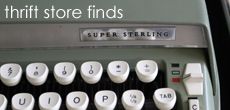Readymade
Magazine used to exist, and it was awesome. It was owned by Better Homes and Gardens, but it was younger and hipper, and
something else I just can’t quite put my finger on, and had I been only a few
years older (I read it throughout college) I would have possibly had a reason
and a means to make more of the DIY home projects they offered (I lived in a
dorm). Nevermind the fact that my
subscription was replaced by BH&G
for half a year after they stopped the presses (have you ever read BH&G? not my thing at all), or that
I still get e-mails from BH&G asking me to become a
subscriber, three years later. I don’t
buy many magazines, so I usually end up keeping the ones I do buy for quite
awhile. I have a very small magazine
holder of them on my bookshelf, and five or six of those are old issues of Readymade. But I can’t seem to find the issue that
sparked this post, and it’s not online either.
So I’ll just have to talk about it.
This one particular issue had a section on how to make
your own make-up. In recent years since
this issue of Readymade was
published, DIY culture has been making a strong comeback, so maybe the idea of
making your own make-up won’t raise quite as many eyebrows now (still, a lot of
eyebrows will be raised). Well, don’t
think I’m crazy, but when it comes to most things, if there is a way to make my
own, I am interested to learn. I haven’t
learned to make everything…yet. But I wouldn’t mind trying.
In the Readymade
article, there were recipes for mascara, lipstick, and perfume. And then there was this: blush. There’s nothing to make, really. Just get it
and use it. I finally got around to this
just this week, six or seven years after reading the article, and I wish I hadn’t
waited as long.
Blush. It makes your cheeks rosy, you know.
Several years ago, I used to use a blush by Rimmel. Here’s the ingredients list:
Talc, polyethylene, caprylic/capric triglyceride, magnesium stearate, tridecyl trimellitate, PTFE, hydrogenated polydecene, methylparaben, polyglyceryl-3 diisostearate, propylparaben, silica dimethyl silylate, butylparaben. May contain: Mica, iron oxides (CI 77491, CI 77492, CI 77499), titanium dioxide (CI 77891), D&C red No. 7 calcium lake (CI 15850), ultramarines (CI 77007), D&C red No. 30 aluminum lake (CI73360), D&C red No.6 (CI 15850), FD&C yellow No. 5 aluminum lake (CI 19140), ferric ferrocyanide (CI 77510), manganese violet (CI 77742), carmine (CI 75470), tin oxide
Talc, polyethylene, caprylic/capric triglyceride, magnesium stearate, tridecyl trimellitate, PTFE, hydrogenated polydecene, methylparaben, polyglyceryl-3 diisostearate, propylparaben, silica dimethyl silylate, butylparaben. May contain: Mica, iron oxides (CI 77491, CI 77492, CI 77499), titanium dioxide (CI 77891), D&C red No. 7 calcium lake (CI 15850), ultramarines (CI 77007), D&C red No. 30 aluminum lake (CI73360), D&C red No.6 (CI 15850), FD&C yellow No. 5 aluminum lake (CI 19140), ferric ferrocyanide (CI 77510), manganese violet (CI 77742), carmine (CI 75470), tin oxide
You can probably infer
just based on the fact that the list is so daunting, that not all of these
things are so great to have seeping into your pores daily. And the ingredients lists for most over the
counter make-up look exactly like this.
You can look up each of these ingredients and their toxicity levels (and whatever else is in your particular brand of choice) here. The parabens are particularly
bad.
Two and a half years ago,
I started using several products from Just Pure Minerals. It is a small business and all of the
products are mixed up by hand! They are
all vegan and non-toxic and totally trustworthy. I absolutely love their mineral foundations
and powders, and I don’t see myself trying to make that anytime soon. I love their blush too. The ingredients list for the Just Pure
Minerals blush:
Mica, titanium dioxide, iron oxides.
Mica, titanium dioxide, iron oxides.
The cost is $12, for an
amount that will last me well over 6 months.
So if you don’t decide to make your own make-up after reading this post,
check out Just Pure Minerals for some non-toxic, handmade make-up. I will be their spokeswoman any day.
On the other hand, if you
want to make your own blush, here’s what you do: buy some beet powder. Use it as
blush. The end! What! Yes.
Too good to be true. I was
skeptical, but it’s awesome. I was
mostly unsure of the color, because beet powder is a bit on the magenta side,
and I normally choose a blush more on the orange side. However, the color looks great and does not
come across as magenta or purple on my skin.
I had a hard time finding
beet powder locally, although I plan to try again when I run out of my current
stock. I ended up buying it from Ancient Indigo herbs on Etsy, and would highly recommend them. They grow many of the products for sale in their
shop on their own farm! I fully support
that.
Can you make beet powder
from an actual beet? Yes. You absolutely can, I found out with a little internet searching. Just cut a beet into
slices, dehydrate them, and crush them into a fine powder.
If you're still wondering why someone would want to do this...why would anyone not want to use blush made from a simple beet, and keep using a ton of dangerous chemicals instead?








